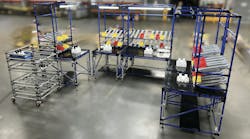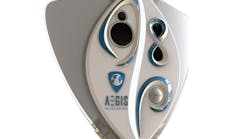Life without ladders would be impossible. We use them to elevate us to heights so that we can complete the repair or task at hand. The basic structure of ladders is the same, but they have their distinct differences that make them a better fit for certain jobs than others. Discover which ladder will be best for your projects.
Rolling Ladder
Rolling ladders are available in many varieties: painted steel, powder coated steel, galvanized steel, aluminum and 304/316 stainless steel.
Painted enamel steel rolling ladders will serve to get you to where you need to be. These rolling ladders are the most economical choice for most environments. If you keep the scratches covered with regular maintenance these ladders will last a long time.
An aluminum rolling ladder will prove to be extremely user friendly and easy to maneuver because of the lightweight and non-magnetic design. They can stand up to harsher chemicals in wash down areas and customizable welds can be used in industries requiring sterile environments including pharmaceutical and food service.
Stainless steel rolling ladders are best suited for environments with harsh conditions. These heavy-duty rolling ladders can withstand corrosive environments to enable continued use for a prolonged period. These ladders can be made “clean” with special welds.
Since these ladders can lock into a stationary position when someone is on it, they are unlikely to move when in use.
Apart from differing materials, there are other subcategories of rolling ladders. For example, a 360-deg. rolling ladder permits you to spin around on its axis. A safety rolling ladder will elevate you to many hard to reach areas, while a multidirectional rolling ladder can squeeze into compact spaces and move around easily.
Some other types of rolling ladders that available are:
- Cantilever: easily get over obstructions and protrusions
- Monster: heavy duty loads and for Canadian compliance
- 50 Degree Slope: descend while facing forward
- Stock Picking: place products on the shelves of the ladder
- Tilt and Roll: maneuvered like a wheelbarrow
- Spring Loaded Casters: automatically unlocks when someone steps off
- Truck and Dock: ideal for working around trucks, docks, or any other environment needing extra height
- Maintenance: useful tool in a repair shop and many manufacturing environments.
Rolling ladders have a safety factor of 4 which means they must be able to support loads four times the anticipated rating. They are able to support at least 300 lb. to account for the worker and tools as well.
Different ladder models may have 16, 24 or 30-in. wide slip-resistant steps. The steps receive their anti-slip properties due to dimpling, shot blasting, knurling or other methods. Rolling ladders are trustworthy and safe since they must undergo various tests to verify their resilience. Labels will be on the products for load instructions.
If you overload the ladder past its maximum capacity it could malfunction. You will need to comply with the weight limit sticker on the ladder. Before using a newly purchased rolling ladder, make sure that all the connections are completely tight and there is no wobbling.
Crossover Ladders or Crossover Platforms
Crossover ladders are manufactured from aluminum, steel, and stainless steel to meet your needs and must be fastened to the floor. Crossovers are perfect for extending over a conveyor belt or other hazardous area including rooftop pipes, indoor floor pipes and any obstacle one needs to traverse.
A space saver crossover model is available to give you more space in your working area. You can select off the shelf crossover platforms to execute tasks for many situations. The sturdiness of stainless steel makes those models of crossover ladders well suited to heavy duty situations and corrosive environments.
To best fit your needs, custom crossovers are also available. Investing in a custom crossover platform will help you to safely move past conveyor belts, machinery, water lines, electrical conduits and other similar obstructions.
Crossover ladders can be used for a variety of different purposes including the following:
- Reach Controls/Gauges
- Better Time and Motion
- Serve as Platform for Supervisors
- Cross Conveyor Belts
- Cross Pipe Lines
- Avoid Trip Hazards
Crossover platforms make it easier for you to transport heavy loads up and down your ladder without worrying about falling. These ladders are in effect the equivalent of stairs connected by a bridge. Crossover platforms permit access from either side of the structure.
In addition to crossing over conveyor belts, these ladders are also perfect for extending over machinery, too. Rails run from the top to the bottom of these ladders to enhance your safety during use.
Folding Ladder
You can purchase either a stainless steel, powder coated, or painted steel folding ladder. With these types of ladders, you get to enjoy the features of rolling ladders with the perk of space-saving storage. You only have to remove bolts from the ladder when you are done using it which then permits you to fold the ladder and easily wheel it to storage.
A folding ladder is a sensible choice if you need to use the ladder over different terrain. Its large wheels let the ladder travel over rough terrain.
You can use folding ladders in a variety of settings. They function well in commercial settings, offices, warehouses and industrial locations. The rubber wheels on folding ladders also make it easy to transport the ladder for different projects that arise.
Folding ladders are created to make it easy for you to reach elevated surfaces. Tilt and roll mobility, that is characteristic of folding ladders, will make it easy for you to transport your ladder from location to location.
A folding ladder supports itself which means you do not have to prop it against a supportive surface. This feature makes a folding ladder ideal for general use indoors.
You can expect to safely use one of these ladders if you weigh 250 lb. or less. Their small size is appealing when doing minor jobs that should not require lugging out an extra bulky ladder.
These ladders are characterized by smaller steps and a correspondingly wider base for maximal stabilization. Folding ladders can be purchased in larger or smaller varieties. It just depends on how big the job is you must complete.
Fixed Ladder
Fixed ladders are constructed from aluminum, painted steel, galvanized steel, powder coated steel, and 304/316 stainless steel. Stainless steel models normally cost a little more, but they can be used in corrosive environments. You can even have a custom fixed ladder created to make it perfectly suited for the job site or project at hand. Standard fixed ladder varieties include:
- Vertical Fix
- Wall Mounted Ladder with Rails
- Wall Mounted Ladder without Rails
- Walk Through Dock
- Side Step Dock
OSHA requires that you be within 12 in. of the ground [or supply a ladder to reach the bottom rung]. The best way to find the perfect ladder is to measure from the top of the structure to the ground. This way we can get you exactly what you need for compliancy.
Fixed ladders are perfect for gaining access to roofs, lofts, pits, elevated platforms and docks. They do require support as they are permanently fixed to a structure. Since you cannot remove and store these ladders, maintenance is key.
You should be prepared to inspect the fixed ladders at least once a year to stay knowledgeable of any potential rust, decline or corrosion. This inspection should be comprehensive and involve an analysis of the major aspects of the fixed ladder. These include:
- Rungs
- Side Rails (if applicable)
- Supports
- Fasteners
- Anchors
- Ladder Safety System
- Hatches and Opening Arms
- Platforms
- Side Rail Extension Anchors
A successful inspection will be one in which no bolts or welds are found missing and the joints sustaining the rungs and side rails are still tight. Anytime you do notice any defects, you should no longer use that ladder until it is properly repaired.
Whenever your fixed ladder is repaired, the repair materials should be comparable to those originally used in the ladder's construction.
Conclusion
These four primary types of ladders will allow you to tackle diverse jobs in a multitude of settings. Make a list of your needs beforehand and thoroughly research the safety and maintenance for each type of ladder so you can select the ideal ladder to meet your needs.
?









